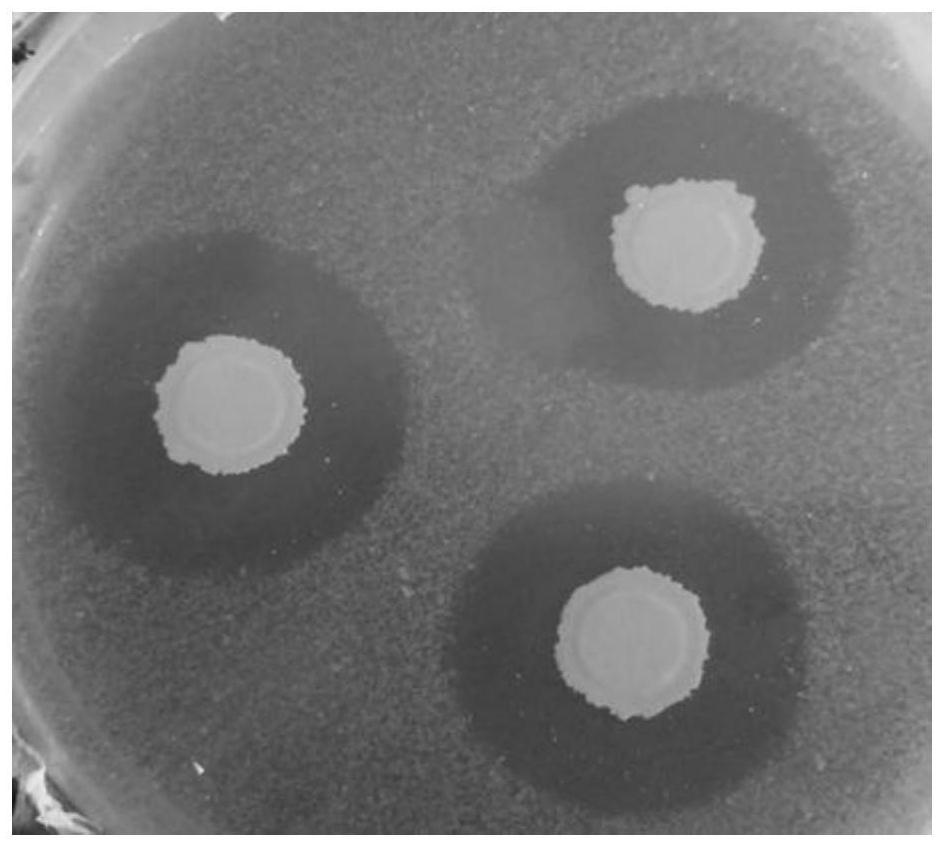A strain of Bacillus amyloliquefaciens and its application
A technology for dissolving amyloid spores and bacilli, applied in the directions of application, bacteria, fungicides, etc., can solve the problems such as the prevention and control methods that have not yet been reported, and achieve the effect of strong inhibitory effect
- Summary
- Abstract
- Description
- Claims
- Application Information
AI Technical Summary
Problems solved by technology
Method used
Image
Examples
Embodiment 1
[0036] Embodiment one: the screening of bacterial strain
[0037] 1. Soil sample collection: Soil samples were collected from the asparagus planting area in Mianyang.
[0038] 2. Preparation medium:
[0039] (1) Chitosanase screening medium (g / L): colloidal chitosan 2.0, K 2 HPO 4 0.7, KH 2 PO 4 0.3, (NH 4 ) 2 SO 4 5, MgSO 4 ·7H 2 O 0.5, FeSO 4 ·7H 2 0 0.01, agar 12.0, pH=7.0.
[0040] (2) Broth medium (g / L): peptone 10.0, beef extract 3.0, NaCl 5.0, pH=7.0.
[0041] 3. Preparation of reagents:
[0042] Preparation of colloidal chitosan: Weigh 10 g of fine powder chitosan, add appropriate amount of concentrated hydrochloric acid, and stir on a magnetic stirrer for 4 to 6 hours to fully dissolve, then repeatedly wash and centrifuge with deionized water (4000r / min), and finally A jelly was formed, and then NaOH was slowly added while stirring to adjust the pH to neutral to obtain colloidal chitosan, which was stored at 4°C for later use.
[0043] 3. Primary scr...
Embodiment 2
[0050] Embodiment two: bacterial strain identification
[0051] 1. 16SrDNA sequencing identification
[0052] The genomic DNA of the target strain was extracted, and the 16S rDNA was cloned from the genomic DNA with universal primers for bacterial 16S rDNA (27F: AGA GTT TGA TCCTGG CTC AG; 1492R: TAC GGT TAC CTT GTT ACG ACT T). The PCR results were sent to Shanghai Sangon Biotechnology Co., Ltd. for sequencing, and the sequencing results were compared with BLAST on the Gene Bank website (http: / / www.nicbi.nlm.nih.gov / ), and the gene sequences of the standard strains were found and downloaded. Using MEGA7.0 The software calculates the genetic distance between different strains and draws a phylogenetic tree of bacteria. The 16SrDNA sequencing result is shown in SEQ ID NO 1.
[0053] Compare the target strain with the 16SrDNA of the Bacillus type strain, and use MEGA7.0 to construct a phylogenetic tree, such as image 3 As shown, the genetic distances between strain d1 and Bacillu...
Embodiment 3
[0062] Embodiment three: the indoor test of using Bacillus amyloliquefaciens alone to inhibit the pathogenic bacteria of asparagus stem blight
[0063] 1. Prepare pathogenic bacteria: isolate Phomopsis asparagus, Pestalotiopsis strains, and Curvularia strains from asparagus stem blight diseased strains.
[0064] 2. Preparation of PDA medium (g / L): Cut 200g peeled potatoes into small pieces, boil for 30min, filter the residue with gauze, add glucose 20.0g / L, agar 15.0g / L, pH natural.
[0065] 3. Inoculate the above three types of pathogenic strains in the center of the PDA medium, and culture them in a constant temperature incubator at 28°C until the diameter of the fungal colony is 3 to 4 cm, and then separate them in the four directions of the colony and 0.5 cm from the edge of the colony. Labeled 1,2,3,4. Sites 1 and 3 were used as controls, inoculated with Bacillus subtilis 168 strain, Bacillus subtilis 168 strain, purchased from the German Culture Collection Center DSMZ, ...
PUM
 Login to View More
Login to View More Abstract
Description
Claims
Application Information
 Login to View More
Login to View More - R&D
- Intellectual Property
- Life Sciences
- Materials
- Tech Scout
- Unparalleled Data Quality
- Higher Quality Content
- 60% Fewer Hallucinations
Browse by: Latest US Patents, China's latest patents, Technical Efficacy Thesaurus, Application Domain, Technology Topic, Popular Technical Reports.
© 2025 PatSnap. All rights reserved.Legal|Privacy policy|Modern Slavery Act Transparency Statement|Sitemap|About US| Contact US: help@patsnap.com



